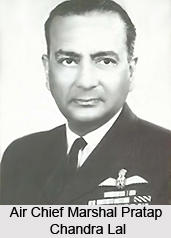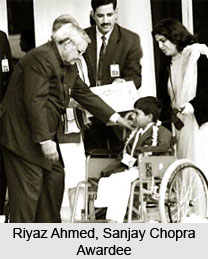 Pratap Chandra Lal was born in December 1917.Though his ancestors were lawyers he had inclination in aviation from his childhood. At the age of 17 he got the Amateur Pilot`s license as the youngest Indian pilot. Pratap Chandra Lal graduated in journalism from King`s College, London in 1938.After that Pratap Chandra Lal took Empire Pilot training at Royal Air Force and was commissioned into the Indian Air Force in Karachi in 1940 as a navigator. Later Pratap Chandra Lal worked as a navigation instructor at Risalpur. In 1941 he was appointed to No.3 Coast Defense Fight, Calcutta. After two months he was appointed as a Navigation Instructor to No.1 Flying Training School at Ambala. After two years Pratap Chandra Lal was posted flying and navigational instructor to the Operational Training Unit at Peshawar.
Pratap Chandra Lal was born in December 1917.Though his ancestors were lawyers he had inclination in aviation from his childhood. At the age of 17 he got the Amateur Pilot`s license as the youngest Indian pilot. Pratap Chandra Lal graduated in journalism from King`s College, London in 1938.After that Pratap Chandra Lal took Empire Pilot training at Royal Air Force and was commissioned into the Indian Air Force in Karachi in 1940 as a navigator. Later Pratap Chandra Lal worked as a navigation instructor at Risalpur. In 1941 he was appointed to No.3 Coast Defense Fight, Calcutta. After two months he was appointed as a Navigation Instructor to No.1 Flying Training School at Ambala. After two years Pratap Chandra Lal was posted flying and navigational instructor to the Operational Training Unit at Peshawar.
In 1943 he joined the No.7 Squadron as a combat pilot. During Burma campaign this squadron was involved in several major battles including Imphal, Kohima, Aryan and Rangoon. In 1945 Pratap Chandra Lal was made squadron leader for his exceptional performances. For his courageous leadership in the war against Japan he was awarded the Distinguished Flying Cross medal. In 1946 he was promoted to the rank of Wing Commander and posted to the Inter-Services Recruiting Office, Calcutta. After five months Pratap Chandra Lal moved to U.K to attend a senior commander`s course.
After returning back to India Air Chief Marshal Pratap Chandra Lal was appointed as Director of Planning & Training in the rank of Group Captain. He again moved to U.K to attend a course at Royal Air Force Staff College. After a year he came back to India and was promoted to the rank of Air Commodore. In 1951 Pratap Chandra Lal captained the Indian Air Force team, which supported the then Nepal King Tribhuvan to face palace coup. Air Chief Marshal Pratap Chandra Lal was also the military secretary to the cabinet for two years. In 1954 he was sent to Europe as a team leader for the assessment of the new aircraft for Indian Air Force. Pratap Chandra Lal was the first Indian to fly supersonic and the Gnat.
In 1957 he was appointed to the Ministry of Civil Aviation as General Manager of the Indian Airlines Corporation. It was during this time he resigned from his service. After few months his service was again reinstated. He was promoted to the rank of Air Vice Marshal and posted as Air Officer Maintenance. In 1963 Air Chief Marshal Pratap Chandra Lal was appointed as Air Officer Commanding-in-Chief Western Air Command. After a year he was posted to Air Headquarters as the Vice Chief of Air Staff. In 1965 Air Chief Marshal Pratap Chandra Lal was awarded Padma Bhushan for his exceptional performances in the war against china. For a short while he was posted in the Training Command. After that he was appointed as the managing director of the Hindustan Aeronautical Ltd. In 1969 he assumed the charge of the Chief of Air Staff. During the war against Pakistan in 1971 his performance was remarkable. It would not be an exaggeration to say that P.C. Lal was the main brain behind the Indian Air Force `s most significant triumph. For exemplary leadership Air Chief Marshal Pratap Chandra Lal was awarded the Padma Vibhushan in 1972. He retired from the Indian Air Force, on 15h January 1973. He also held some crucial advisory posts after his retirement. Air Chief Marshal Pratap Chandra Lal died in 1984.






